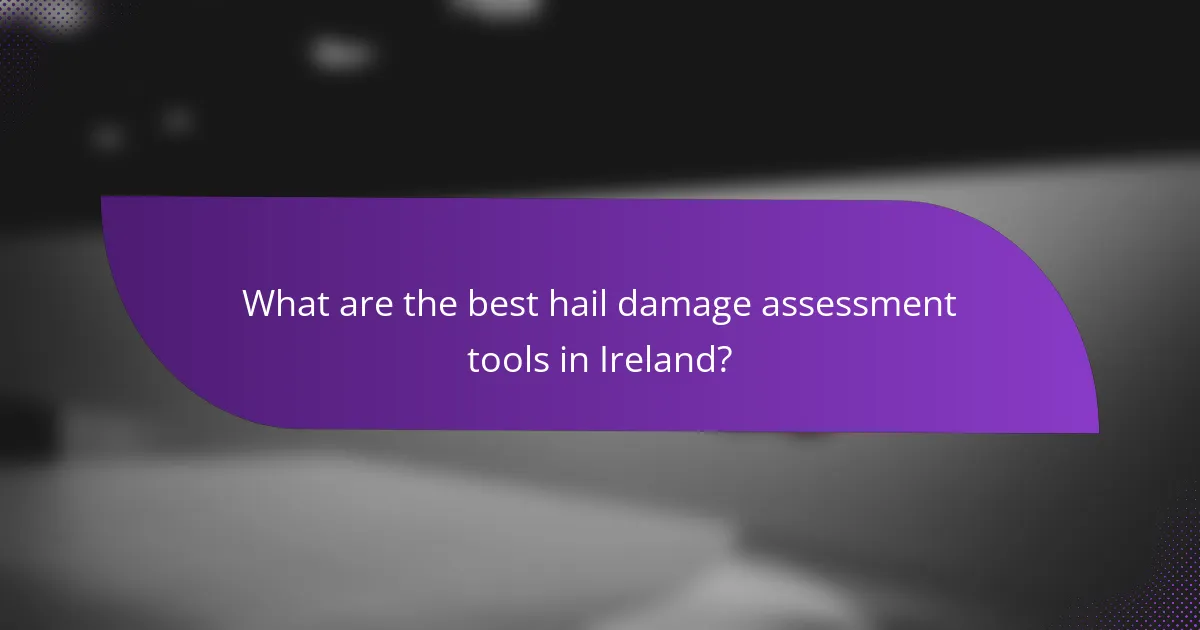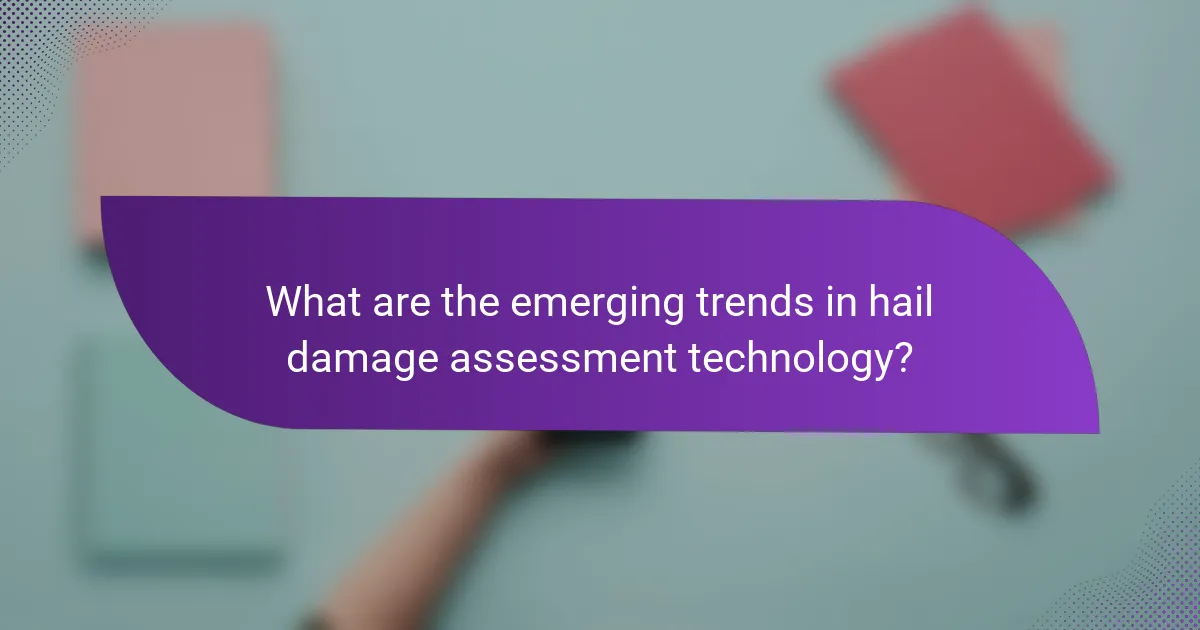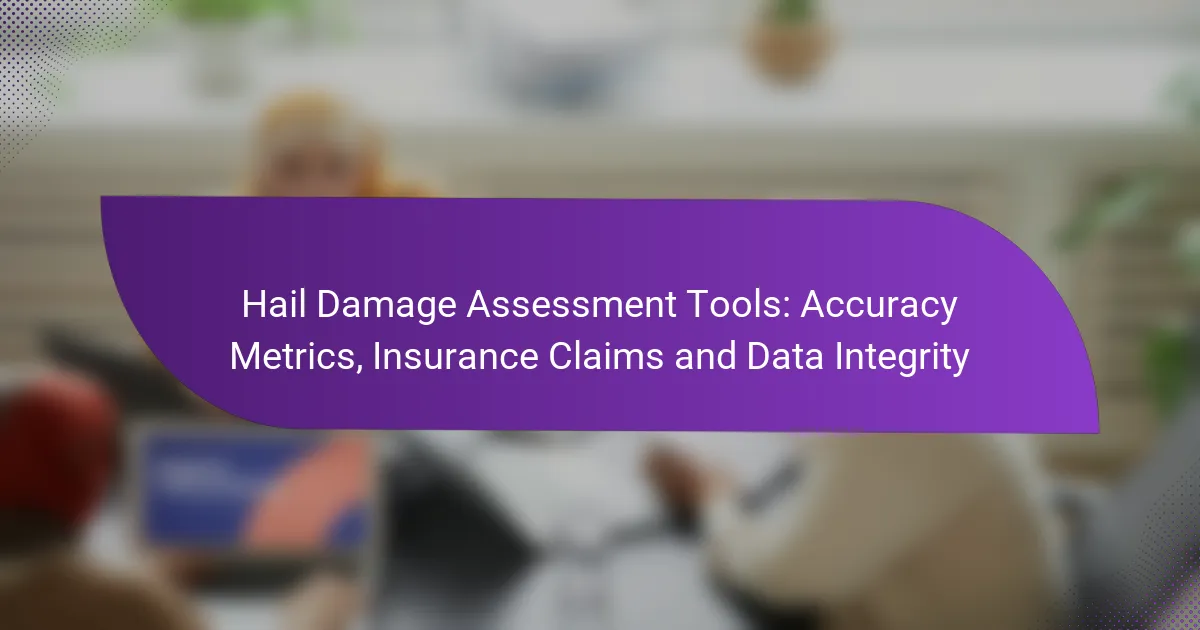Hail damage assessment tools play a vital role in accurately evaluating the impact of hail events on properties, benefiting both owners and insurers. By leveraging advanced technologies such as satellite imagery and weather modeling, these tools enhance the reliability of damage assessments, which is essential for streamlining the insurance claims process. However, users should remain mindful of the varying accuracy levels and potential limitations inherent in different assessment methods.

What are the best hail damage assessment tools in Ireland?
The best hail damage assessment tools in Ireland include advanced technologies that provide accurate data on hail events, helping property owners and insurers evaluate damage effectively. These tools utilize various methods, including satellite imagery and weather modeling, to assess hail impact and support insurance claims.
HailTrace
HailTrace is a leading tool that offers detailed hail event tracking and analysis. It provides users with real-time data on hail size, duration, and path, which is crucial for assessing damage accurately. The platform is particularly useful for insurance adjusters and contractors who need precise information to support claims.
One of HailTrace’s strengths is its user-friendly interface, which allows users to visualize hail events on interactive maps. This feature helps in identifying affected areas quickly, making it easier to prioritize inspections and repairs.
AccuWeather Hail Reports
AccuWeather Hail Reports deliver timely updates on hail storms, including size and location. This tool is beneficial for both homeowners and insurance companies, as it provides historical data that can be used to assess potential damage. Users can access detailed reports that include storm paths and intensity levels.
AccuWeather’s integration with other weather services enhances its reliability, making it a go-to resource for those needing comprehensive weather information. However, users should verify the data against other sources for the most accurate assessments.
HailGuard
HailGuard specializes in providing alerts and reports on hail storms, focusing on protecting property from potential damage. The tool uses advanced radar technology to predict hail events, allowing users to take preventive measures. This proactive approach can significantly reduce the impact of hail on properties.
HailGuard is particularly useful for businesses and homeowners in hail-prone areas. Users can set up alerts to receive notifications when hail is forecasted, enabling them to prepare in advance and mitigate damage risks.
StormGeo
StormGeo offers a comprehensive suite of weather services, including hail damage assessment tools. Their platform combines meteorological expertise with advanced technology to provide accurate hail forecasts and assessments. This tool is ideal for insurers and contractors who require detailed weather insights to support their operations.
With StormGeo, users can access historical data and predictive analytics, which are essential for understanding hail patterns and potential impacts. This information can guide decision-making for repairs and insurance claims.
WeatherBug
WeatherBug provides real-time weather information, including hail alerts and reports. It is a user-friendly app that allows homeowners to stay informed about severe weather conditions. The tool offers localized data, making it particularly relevant for users in specific regions of Ireland.
While WeatherBug is effective for general weather tracking, users should complement it with more specialized tools for detailed hail damage assessments. Combining multiple sources can enhance the accuracy of damage evaluations and insurance claims.

How accurate are hail damage assessment tools?
Hail damage assessment tools vary in accuracy, often depending on the technology and data sources used. Generally, these tools can provide reliable estimates, but users should be aware of potential discrepancies and limitations in specific scenarios.
Accuracy metrics of HailTrace
HailTrace employs a combination of radar data, satellite imagery, and ground reports to assess hail damage. Its accuracy metrics typically range from 80% to 90%, depending on the geographical area and the severity of the hail event. Users can expect detailed reports that highlight the size and path of hailstorms, which aids in damage evaluation.
However, factors such as local topography and weather conditions can influence these metrics. Users should consider these variables when interpreting HailTrace’s assessments for insurance claims.
Comparative accuracy of AccuWeather
AccuWeather’s hail damage assessments are based on predictive models and historical data, achieving an accuracy level of around 70% to 85%. While it provides useful forecasts, its reliance on models means that real-time accuracy may vary, especially in rapidly changing weather situations.
For users seeking precise assessments, it’s advisable to cross-reference AccuWeather’s reports with other tools like HailTrace. This can help ensure a more comprehensive understanding of potential hail damage.
Data validation methods
Data validation methods for hail damage assessments include cross-referencing multiple data sources and utilizing ground truthing techniques. This involves comparing tool outputs with actual damage reports from insurance claims or on-site inspections to ensure reliability.
Additionally, regular updates and calibrations of the assessment models are essential. Users should look for tools that incorporate feedback loops from recent hail events to improve future accuracy. This practice helps maintain data integrity and enhances the reliability of assessments over time.

What role do assessment tools play in insurance claims?
Assessment tools are crucial in streamlining the insurance claims process by providing accurate evaluations of hail damage. These tools help insurers quickly determine the extent of damage, which can significantly influence claim outcomes and processing times.
Claim processing efficiency
Efficient claim processing is essential for both insurers and policyholders. Assessment tools can reduce the time required to evaluate claims from days to hours, allowing for quicker resolutions. For example, automated damage assessment software can analyze images of hail damage and generate reports in real-time, expediting the claims process.
To maximize efficiency, insurers should ensure that their assessment tools are user-friendly and integrate seamlessly with existing workflows. This minimizes the learning curve for staff and helps maintain consistent processing times.
Impact on claim approval rates
The accuracy of assessment tools directly affects claim approval rates. Tools that provide reliable damage assessments can lead to higher approval rates, as they help insurers make informed decisions based on solid data. Studies suggest that claims evaluated with advanced tools may see approval rates increase by significant margins compared to traditional methods.
Insurers should regularly review the performance of their assessment tools to ensure they are meeting accuracy standards. This can involve comparing tool-generated assessments with on-site evaluations to identify any discrepancies and improve reliability.
Integration with insurance platforms
Integrating assessment tools with insurance platforms is vital for maximizing their effectiveness. A well-integrated system allows for seamless data transfer between the assessment tool and the claims management system, reducing manual entry errors and improving overall data integrity.
When selecting assessment tools, insurers should prioritize those that offer robust APIs or built-in integrations with popular insurance software. This ensures that data flows smoothly, enabling quicker access to information and more efficient claim handling.

What are the key metrics for evaluating data integrity?
Key metrics for evaluating data integrity include data source reliability, real-time data updates, and historical accuracy comparisons. These metrics help ensure that the data used for hail damage assessments is trustworthy and accurate, which is crucial for insurance claims and decision-making.
Data source reliability
Data source reliability refers to the credibility and trustworthiness of the information providers. When assessing hail damage, it is essential to use data from reputable sources such as government meteorological agencies or established weather services. Checking the credentials and historical performance of these sources can help determine their reliability.
Consider using multiple data sources to cross-verify information. This can help mitigate risks associated with relying on a single source, which may have biases or inaccuracies. For instance, comparing data from local weather stations with satellite imagery can provide a more comprehensive view of hail events.
Real-time data updates
Real-time data updates are crucial for timely decision-making in hail damage assessments. The ability to access the latest information allows for quicker responses to claims and repairs. Look for tools that provide continuous updates, ideally within minutes of a hail event.
Utilizing platforms that integrate real-time data feeds can enhance the accuracy of assessments. For example, using apps that notify users of hail activity as it occurs can help insurance adjusters and homeowners respond more effectively to damage.
Historical accuracy comparisons
Historical accuracy comparisons involve analyzing past data to evaluate the precision of current assessments. By reviewing previous hail events and their documented impacts, you can identify patterns and improve future predictions. This analysis can also help in understanding the typical severity and frequency of hail in specific regions.
To perform effective historical comparisons, maintain a database of past hail incidents, including their size, duration, and damage reports. This can serve as a benchmark for assessing new claims and determining the reliability of current data sources.

How do hail damage assessment tools integrate with SaaS platforms?
Hail damage assessment tools often integrate with Software as a Service (SaaS) platforms to streamline data collection and analysis. This integration enhances the efficiency of insurance claims processing and improves data accuracy, allowing for better decision-making in damage assessments.
API integration capabilities
API integration is crucial for connecting hail damage assessment tools with SaaS platforms. These APIs allow seamless data exchange, enabling real-time updates and access to critical information. For example, an API can facilitate the automatic transfer of assessment results to an insurance provider’s system, reducing manual entry errors.
When evaluating API capabilities, consider factors like response times, data formats supported, and authentication methods. A well-designed API can significantly enhance user experience and operational efficiency.
Data sharing protocols
Data sharing protocols define how information is exchanged between hail damage assessment tools and SaaS platforms. Common protocols include REST and SOAP, which dictate the structure and format of data transmission. Choosing the right protocol is essential for ensuring compatibility and security.
It’s important to ensure that data sharing complies with relevant regulations, such as data protection laws. Implementing encryption and secure access controls can help safeguard sensitive information during transmission.
User interface compatibility
User interface compatibility ensures that hail damage assessment tools work smoothly within SaaS platforms. A consistent user experience across different systems can enhance user satisfaction and reduce training time. Look for tools that offer customizable interfaces to match the SaaS platform’s design.
Testing for compatibility across various devices and browsers is also vital. Ensuring that the interface is responsive and intuitive can significantly impact the efficiency of users when navigating through assessment data and claims processes.

What are the emerging trends in hail damage assessment technology?
Emerging trends in hail damage assessment technology focus on enhancing accuracy and efficiency through advanced tools. Innovations such as AI, machine learning, and drone technology are transforming how assessments are conducted, leading to faster and more reliable evaluations.
AI and machine learning applications
AI and machine learning are revolutionizing hail damage assessments by automating data analysis and improving accuracy. These technologies can analyze vast amounts of data from various sources, including satellite imagery and weather patterns, to predict damage likelihood and severity.
For instance, machine learning algorithms can be trained on historical hail damage data to identify patterns and correlations, allowing for more precise assessments. This can significantly reduce the time needed for evaluations, often completing analyses in a matter of minutes compared to traditional methods that may take days.
When implementing AI tools, it is crucial to ensure data integrity and quality. Regularly updating training datasets and validating model outputs against real-world assessments can help maintain accuracy and reliability in claims processing.
